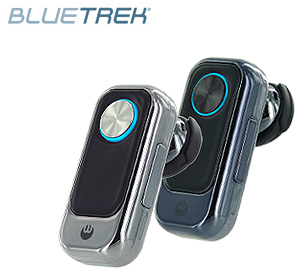
Just as there are a few people who still want a phone that does nothing more than make calls, there are more than a few people who will gladly forgo stereo music playback, voice prompts and other fancy features for a simple headset that's easy on the eyes and easy on the ears.
The last Bluetooth headset I reviewed was another headset from Bluetrek their higher-end UFO, which features voice alerts, two dedicated buttons for preprogrammed numbers, and the sci-fi industrial design of its namesake. Aside from those differentiators, I expected the sound and functionality of the Bluetrek Mini to be largely identical, which wouldn't be a bad thing at all. Let's see how things turned out.
Looking Inside the Box
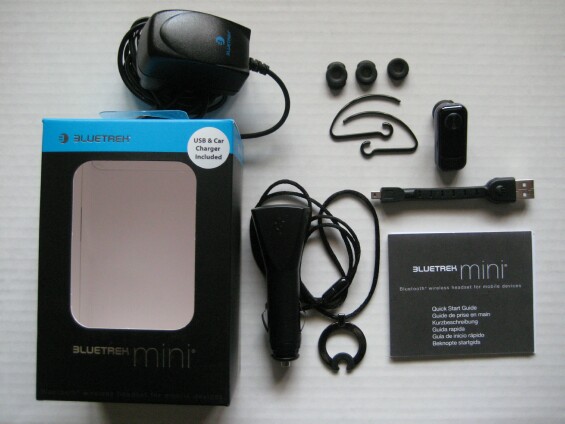
In terms of how Bluetrek has packaged and accessorized the Mini, it really is similar which is a great thing, because it means that it has:
- The headset
- 3 sizes of ErgoBUDs
- A wall charger
- A car charger
- A USB charger
- A lanyard
- 2 sizes of earhooks
- A Quick Start Guide
A more complete package than many headsets at twice the price, especially the full complement of chargers: wall, car and USB. You're not left hanging with just one of the three, as many otherwise good companies increasingly find acceptable. The charging socket on the headset is micro-USB. All that's missing is the full manual, which has to be downloaded from Bluetrek's website.
Unlike headsets from other companies, Bluetrek headsets can't be used straight out of the box; they come uncharged. The initial charge took three of the four hours the manual said it would definitely postponed gratification. Instead of alternating colors, the indicator light around the talk button remains a solid red while charging, then goes off when fully charged. The battery is rated at up to seven hours of talk time, and up to 10 days of standby time.
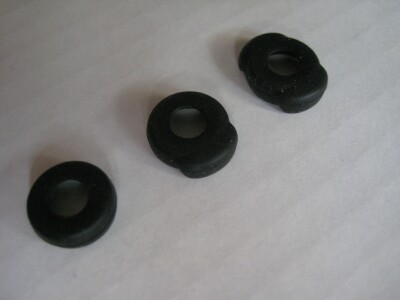
ErgoBUDs? That sounds like something you'd find hatching inside of the UFO headset, but they're actually Bluetrek's trademarked, patent pending moniker for earbuds with an additional crescent of rubber around one side of their perimeter.
Design and Comfort
The ErgoBUD trademark seemed silly, a desperate attempt to differentiate a mere earbud from that of other companies. Once I put the headset on, I stopped laughing. As someone who dislikes headsets that are designed to be worn primarily with their earbuds, with earhooks intended as optional, I was surprised at how comfortable and secure the earbuds er, ErgoBUDs were. The extra rubber on the side really does make a difference. The bud that came on the unit was a perfect fit, so I left it as-is, but there are three sizes included.
It doesn't hurt that the Mini is extremely light (about 10 grams), so it's not difficult at all to wear without an earhook. The earhooks themselves, being plastic, don't look very durable; nor do they look very comfortable they arc from a 45-degree angle. But when I put them on, they more or less vanished from my awareness after a minute or two. They're so thin and light, that there's enough play in the plastic to keep from pinching your ear.
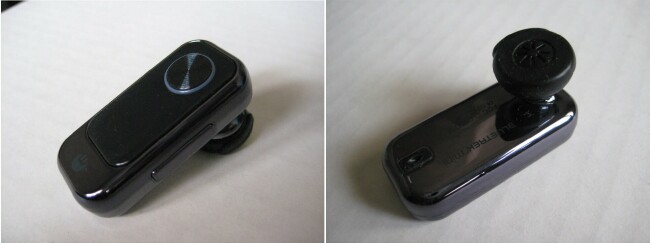
The Mini has two buttons: a volume button on the top (or bottom, relative to the lettering on the inside), and a talk button on the out-facing side. The positioning of the talk button is less than ideal if you have a tendency to push in buttons with more force than necessary. You're basically pushing the ErgoBUD further into your ear each time you need to use this multifunction button. Though it doesn't look like it, the volume button is actually a rocker switch, so the up/down volume orientation isn't obvious at first glance the side toward the talk button is volume-up.
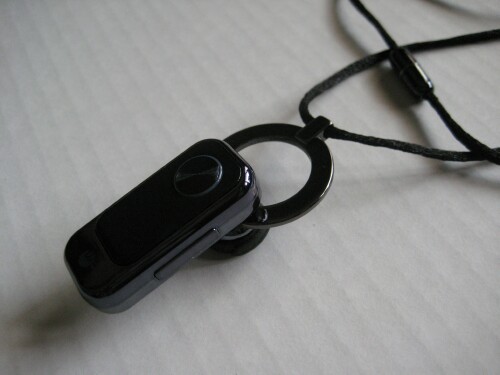
Most lanyards that come with Bluetooth headsets are pretty utilitarian, but the Mini features an attractive plated ring pendant that snaps onto the base of the earphone. Between the headset's plated surface, its rounded corners, and the design of the pendant, the Mini almost looks like jewelery when hung from your neck.
Setup and Operation
Setting up the Mini was more intuitive than the UFO. You press and hold the talk button for about seven seconds until the indicator flashes an alternating blue and red. Enter Handsfree Setup on the Treo, search for nearby devices, and enter the 0000 passkey.
I've always griped about long press-and-hold times on multifunction buttons, and here the complaint stands. It takes fives seconds to turn the unit on, and seven seconds to turn it off. Again, since the talk button is on the side rather than the top or bottom, that's five to seven seconds you're pressing the headset against your ear.
Fortunately, the other multifunction operations are more straightforward than the UFO. To accept or end a call, just click the talk button once. To transfer an active call to the handset, double click the talk button (on the UFO, you have to press and hold ugh). To transfer an active call from the handset, click the talk button once.
Call waiting requires a press-and-hold for three seconds. Fortunately, this is the only press-and-hold operation you'll have to make during an active call. On other headsets, it's easy to accidentally do things like mute the mic when you meant to transfer the call to the handset. Rejecting an incoming call requires a two-second press-and-hold, and redialing the last number requires a three-second press-and-hold.
The Sound
I expected the sound quality to be identical to the UFO, assuming that they shared the same internal circuitry, but that wasn't the case. Both headsets have a slight distortion in the lower high frequencies, but the UFO amplifies the bass and midrange more, making the inbound voice quality more full-bodied than the Mini. The Mini did fine on my voicemail tests, but during actual calls, the flat sound combined with the modicum of midrange distortion was a problem whenever I was in a public setting with much talking in the background.
The Mini also lacks the UFO's noise reduction and echo cancelling, features that are starting to make their way into even mid-level headsets. The Samsung WEP430, which I reviewed back in May, is an example of a headset that's the same price of the Mini, but with noise reduction and echo cancelling. But in fairness, the Mini is much smaller (and better looking, IMO), and simpler to operate.
One small but not insignificant feature of the Mini is its centered microphone placement. With the microphone hole on the inside face of the headset, set in the middle, you can wear the unit on either ear for the same level of pick. In contrast, the UFO has its microphone on the top edge, facing away from your mouth if worn on your left ear.
Conclusion
For size, fit, usability and aesthetic elegance, the Bluetrek Mini is a great headset. It's easy to operate, looks nice, has a full set of chargers, and can actually (not allegedly) be worn comfortably without the earhook. The sound is pretty average, so if call clarity is a priority, you'll probably have to settle for a larger or more expensive headset. But the Mini is a good compromise.
|
|
| Pros |
Includes chargers for wall, car and computer
Extremely comfortable earbud
Light enough to wear without an earhook
Microphone centered for identical sound pickup when worn on either ear
|
|
| Cons |
Plated surface smudges very easily
Non-exceptional sound quality |
|